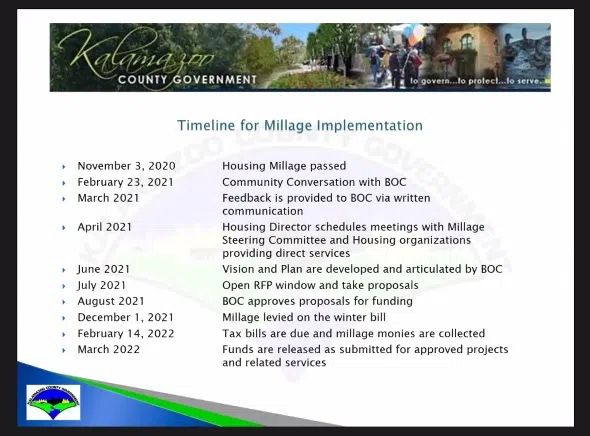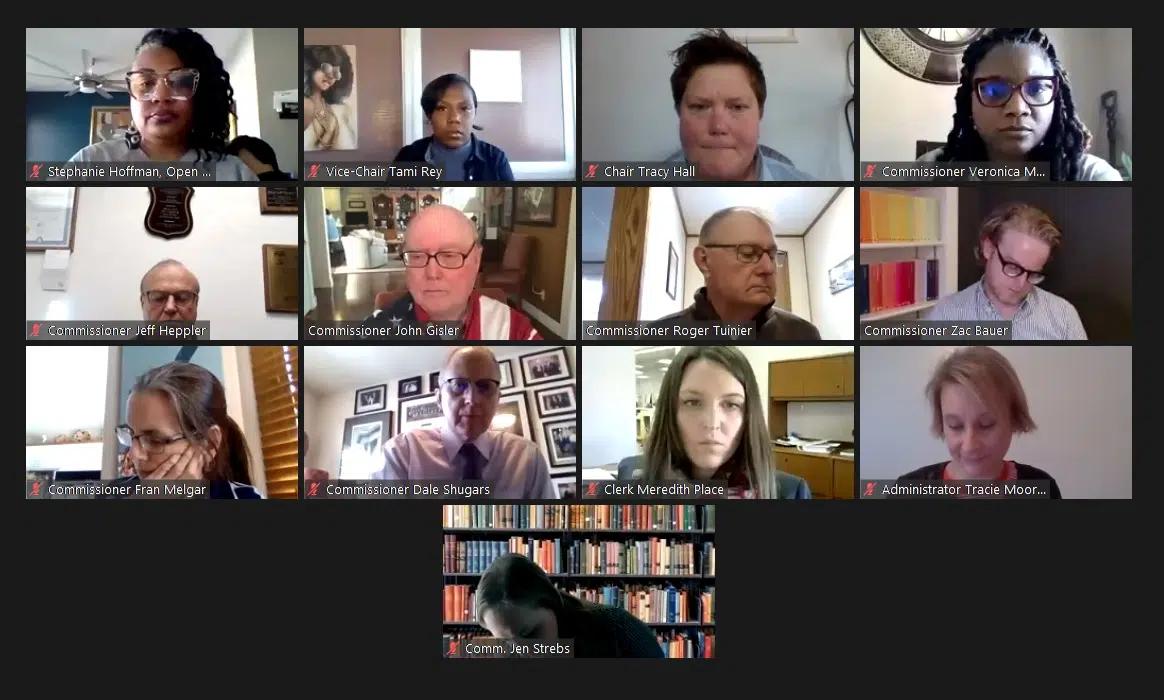KALAMAZOO COUNTY, MI (WKZO AM/FM) — Tuesday, the Kalamazoo County Board of Commissioners began discussion on how to spend the revenue from the “Homes for All” millage that was passed by voters last November.
As written, the revenue is .75 mills for eight years, which would cost the owner of a $100,000 home about $38 per year. That would help raise about $6.3 million dollars in the first year and about $50 million over the eight year life of the millage.
The money would be used to provide rental subsidies and permanent housing for those who need it and offer other related supportive services for residents in Kalamazoo County.
There has been concern about the conditions of homeless encampments in the city, with the news of frigid temperatures and propane tank explosions.
During a special virtual meeting held Tuesday over Zoom, County Commissioners met with community leaders to begin collecting input on the best way to use that money.
In addition to collecting input, Commissioners were trying to receive answers to the following three questions:
- What types of rental subsidies should be included in the millage funding?
- What types of housing do you envision?
- What related supportive services do you think are needed for residents in Kalamazoo County?
Before presentations were made, callers provided input and ideas for about an hour.
One caller, who said he had been homeless before receiving help from Kalamazoo Gospel Ministries and Urban Alliance, said he would like those two organizations to work together to help find affordable and accessible housing for those who need it.
He suggested purchasing homes and setting them up for homeless individuals would be one idea, with the requirement that they attend Urban Alliance for guidance with issues such as drug addiction and financial help.
Other callers said that the entire system of accessible and affordable housing must be implemented through an equitable lens, with an emphasis on diversity and inclusion.
Caller Stephanie Williams said more diversity training would be needed on a county level to ensure that the millage revenue would be spent properly.
“This is why people can’t access and fully gain real, ongoing support through these programs,” Williams said. “The programs fail because at the root of them, they’re not established correctly. And yet, not one of your three questions asks internally, ‘what do you do,’ ‘how are you changing,’ ‘how are you evaluating,’ ‘how are you holding your partners accountable,’ ‘what does your memorandum of understanding with these agencies and organizations look like,’ so that people get the real help, support and funding that the taxpayers are paying their earnest dollars to get.”
Other callers said that any case workers involved in efforts like these should have equity training, as well.
Still others said there are not enough affordable units of any kind to begin with, and that the purchase or construction of more should be a priority. One caller said that as many as 700 available units should be available.
Many also pointed out that the rental subsidies and credits must be available as a means to achieve housing, with Williams saying that they should be available for an extended period of time to those who need them.
Other suggestions that were brought up included focusing on multiple income levels, rather than one, and that the focus must be on the entire area of Kalamazoo County itself, rather than one area like the City of Kalamazoo.
When it comes to what types of housing units should be available, residents commented that multiple types are needed. Those include single-family units, tiny homes, single-room occupancy, and 3 to 4-bedroom units for families.
In discussing how those units should be built, one caller said that they must be designed with ADA-friendly accessibility. In other words, she said that those dimensions must be friendly to those with disabilities and/or the elderly. She added that specific modifications could be made in existing units.
When it came to the discussion of supportive services that should be available, there were many suggestions on what can be done.
“The major support that most people need is advocacy to getting a living wage,” Stephanie Williams added. “They are spinning their wheels over and over again when all they need is a job or career opportunity that will pay them enough to sustain themselves and their families. I think local government should leverage its influence and resources around public policy that gets us to that, and they can start at home themselves with making sure their employees are getting that.”
She said that affordable housing must also be clean housing, referring to substandard living conditions that include rats, mold and other health disparities.
“We’re not tackling those health issues head-on, those are the types of services that people need that when they already have housing, help them be in a place with a roof over their head that isn’t killing them environmentally-wise,” Williams said. “Make them enforce those standards so that they provide healthy housing to our children.”
Other suggestions were made for mental health assistance, substance abuse problems, and other such related topics.
After fielding comments and listening to community presentations, this input workshop concluded after about two and a half hours, with Housing Director Mary Balkema sharing an estimated timeline of when the funds will be disbursed.

Timeline of public housing millage fund disbursement. (Photo courtesy of Kalamazoo County Government via Zoom Meeting).
Board Chair Tracy Hall then spoke on what will be happening in the near future regarding this matter.
“We will be discussing this in March as a group,” Hall said. “Our staff will be compiling all of your feedback, all of the comments we’ve received tonight, and the ones we’ve also received by email over the last two days as well.”
She said discussions will continue at a meeting on March 16, including a decision on whether or not another community input session like this will be held.









Comments